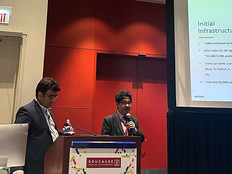Cloud Computing Clusters Represent the Next Great Migration
In an effort to give Moore’s Law a little boost, researchers and the computer scientists who assist them increasingly turn to cloud-based parallel computing to solve complex real-world problems, including finding a cure for cancer and realizing the promise of personalized medicine.
In 2011, Virginia Tech University Professor and Google Scholar Wu Feng created one of the world’s fastest and greenest high-performance computing (HPC) clusters, called HokieSpeed.
As fast as the setup was, Feng realized that very few researchers actually could access it, so he turned to the cloud to help bioinformatic researchers find a cure for cancer. Feng received a grant from the National Science Foundation’s Computing in the Cloud program, designed to help researchers tap cloud-based parallel computing resources to speed up DNA sequencing.
Microsoft is partnering with the NSF to provide free computing infrastructure for the researchers.
The estimated global market for Infrastructure as a Service, the fastest growing segment of cloud computing, by 2016.
SOURCE: Gartner, “Forecast Overview: Public Cloud Services, Worldwide, 2011–2016, 4Q12 Update,” February 2013
“The idea is that institutions or universities or companies that did not have ready access to supercomputers could tap into the cloud, or they could have the cloud work as a back-end supercomputer to their laptop,” Feng says. “Whatever their laptop could not do, they could offload to the cloud.”
Intel is also working with universities and labs through its Intel Parallel Computing Center program, training students, scientists and researchers parallel programming techniques and modernizing community codes.
Cloud Computing Is an On-Demand, Inexpensive Technology Solution
The National Institute of Standards and Technology defines cloud computing, in part, as convenient, on-demand network access to a shared pool of computing resources, which can be configured quickly without much management effort or service provider interaction — helping research teams that require massive amounts of computing power or storage to process their growing pools of data. At Stanford, Professor Atul Butte found that he couldn’t keep up with everything required to provide his graduate students access to onsite HPC resources to run their programs. Possible solutions included purchasing more hard drives and budgeting more money for electricity from the additional cooling that the equipment would use, but he thought the cloud might prove a better alternative.
When a graduate student needed to run a program that a lab computer couldn’t handle, Butte used a credit card to buy time on a third-party cloud platform to run the job.
“In the future, I hope that what we end up providing is a platform that allows people to build their own clouds in a matter of minutes,” says Robert Ricci, a research assistant professor of computer science at the University of Utah and principal investigator of CloudLab, an NSF-sponsored infrastructure for research in cloud computing.
“Personalized medicine — I can see that happening,” Feng says. “The cost of genome sequencing is coming down.”









